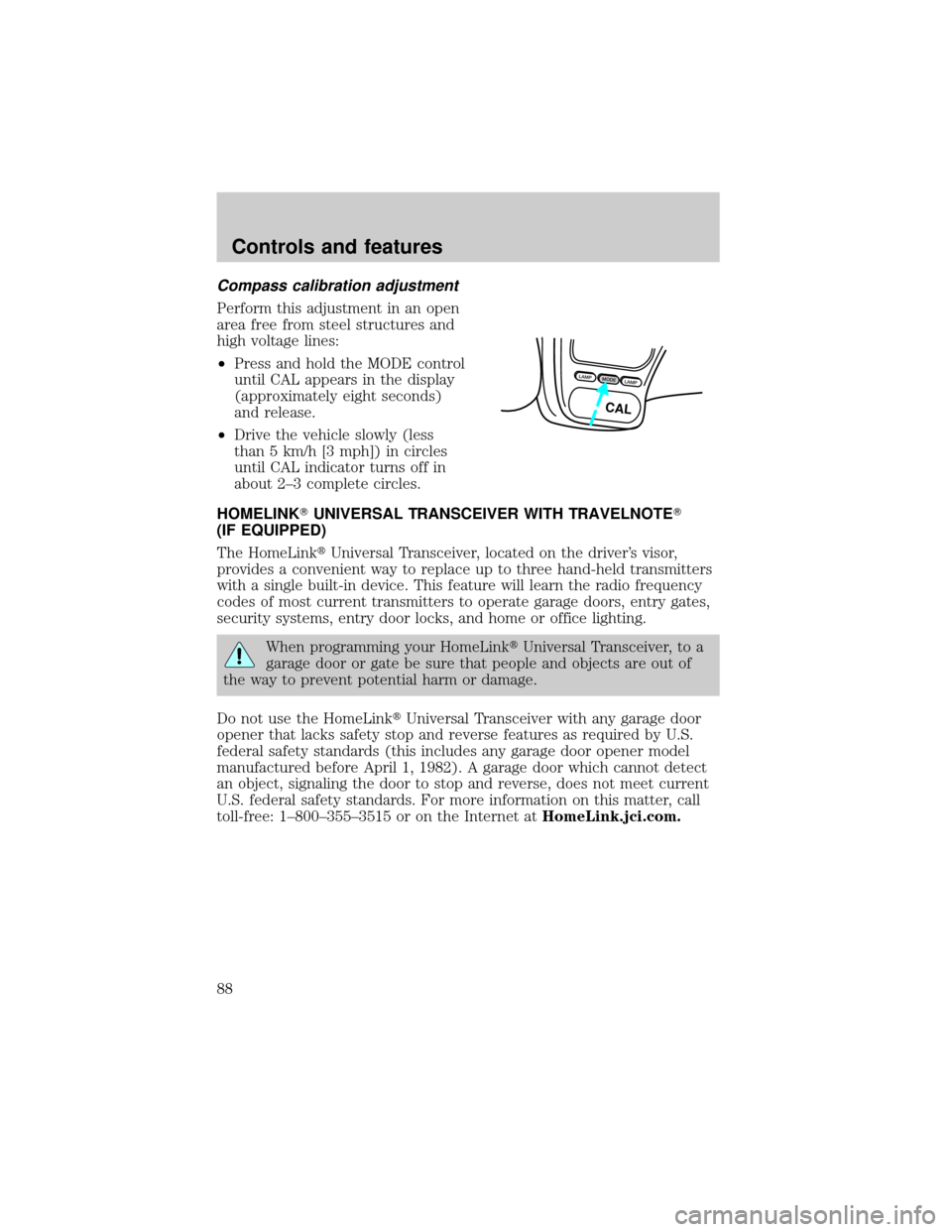radio controls Mercury Mountaineer 2000 s Owner's Guide
[x] Cancel search | Manufacturer: MERCURY, Model Year: 2000, Model line: Mountaineer, Model: Mercury Mountaineer 2000Pages: 264, PDF Size: 2.29 MB
Page 88 of 264

Compass calibration adjustment
Perform this adjustment in an open
area free from steel structures and
high voltage lines:
²Press and hold the MODE control
until CAL appears in the display
(approximately eight seconds)
and release.
²Drive the vehicle slowly (less
than 5 km/h [3 mph]) in circles
until CAL indicator turns off in
about 2±3 complete circles.
HOMELINKTUNIVERSAL TRANSCEIVER WITH TRAVELNOTET
(IF EQUIPPED)
The HomeLinktUniversal Transceiver, located on the driver's visor,
provides a convenient way to replace up to three hand-held transmitters
with a single built-in device. This feature will learn the radio frequency
codes of most current transmitters to operate garage doors, entry gates,
security systems, entry door locks, and home or office lighting.
When programming your HomeLinktUniversal Transceiver, to a
garage door or gate be sure that people and objects are out of
the way to prevent potential harm or damage.
Do not use the HomeLinktUniversal Transceiver with any garage door
opener that lacks safety stop and reverse features as required by U.S.
federal safety standards (this includes any garage door opener model
manufactured before April 1, 1982). A garage door which cannot detect
an object, signaling the door to stop and reverse, does not meet current
U.S. federal safety standards. For more information on this matter, call
toll-free: 1±800±355±3515 or on the Internet atHomeLink.jci.com.
LAMPMODELAMP
CAL
Controls and features
88
Page 104 of 264

Replacing the battery
The transmitter is powered by one coin type three-volt lithium battery
CR2032 or equivalent. Typical operating range will allow you to be up to
10 meters (33 feet) away from your vehicle. A decrease in operating
range can be caused by:
²weather conditions
²nearby radio towers
²structures around the vehicle
²other vehicles parked next to the vehicle
To replace the battery:
1. Twist a thin coin between the two
halves of the transmitter near the
key ring. DO NOT TAKE THE
FRONT PART OF THE
TRANSMITTER APART.
2. Place the positive (+) side of new
battery in the same orientation.
Refer to the diagram inside the
transmitter unit.
3. Snap the two halves back
together.
Replacing lost transmitters
If a remote transmitter has been lost
and you would like to remove it
from the vehicle's memory, or you
would like to purchase additional
remote transmitters and have them
programmed to your vehicle:
²Takeallyour vehicle's
transmitters to your dealer for
programming, or
²Perform the programming
procedure yourself
Controls and features
104
Page 140 of 264

PREPARING TO START YOUR VEHICLE
Engine starting is controlled by the powertrain control system. This
system meets all Canadian Interference-Causing Equipment standard
requirements regulating the impulse electrical field strength of radio
noise.
When starting a fuel-injected engine, avoid pressing the accelerator
before or during starting. Only use the accelerator when you have
difficulty starting the engine. For more information on starting the
vehicle, refer toStarting the enginein this chapter.
Extended idling at high engine speeds can produce very high
temperatures in the engine and exhaust system, creating the risk
of fire or other damage.
Do not park, idle, or drive your vehicle in dry grass or other dry
ground cover. The emission system heats up the engine
compartment and exhaust system, which can start a fire.
Do not start your vehicle in a closed garage or in other enclosed
areas. Exhaust fumes can be toxic. Always open the garage door
before you start the engine. SeeGuarding against exhaust fumesin
this chapter for more instructions.
If you smell exhaust fumes inside your vehicle, have your dealer
inspect your vehicle immediately. Do not drive if you smell
exhaust fumes.
Important safety precautions
A computer system controls the engine's idle revolutions per minute
(RPM). When the engine starts, the idle RPM runs faster to warm the
engine. If the engine idle speed does not slow down automatically, have
the vehicle checked.
Before starting the vehicle:
1. Make sure all vehicle occupants have buckled their safety belts. For
more information on safety belts and their proper usage, refer to the
Seating and safety restraintschapter.
Starting
140
Page 258 of 264

Air bag supplemental
restraint system .................126,130
and child safety seats ............128
description .......................126,130
disposal ....................................133
driver air bag ...................128,131
indicator light ...............9,130,132
operation ..........................128,131
passenger air bag ............128,131
side air bag ..............................130
Air cleaner filter .......................237
Air conditioning ..........................22
automatic temperature
control system ..........................25
rear seat controls .....................31
Air suspension ...........................147
description ..............................147
warning light .............................12
All Wheel Drive (AWD),
driving off road .........................159
Ambulance packages ....................3
Antifreeze
(see Engine coolant) ................200
Anti-lock brake system
(see Brakes) .......................144,145
Anti-theft system
warning light .............................11
Armrests ......................................99
Audio system (see Radio) .........35
Automatic transmission
driving an automatic
overdrive ..........................149,152
fluid, adding ............................206
fluid, checking ........................206
fluid, refill capacities ..............237
fluid, specification ..................242
Auxiliary power point .................98
Axle
lubricant specifications ...240,242
refill capacities ........................237
traction lok ..............................162
Battery .......................................210acid, treating emergencies .....210
charging system
warning light .............................11
jumping a disabled battery ....185
maintenance-free ....................210
replacement, specifications ...237
servicing ..................................210
voltage gauge ............................16
Belt minder ...............................122
Brakes ........................................144
anti-lock ............................144,145
anti-lock brake system
(ABS) warning light ..........10,145
brake warning light ..................10
fluid, checking and adding ....199
fluid, refill capacities ..............237
fluid, specifications ..........240,242
lubricant specifications ...240,242
parking ....................................145
shift interlock ..........................148
Break-in period .............................3
Capacities for refilling fluids ....237
Cargo area shade ......................100
Cargo cover ...............................100
CD changer .................................71
Certification Label ....................244
Child safety restraints ..............134
child safety belts ....................134
Child safety seats ......................135
in front seat ............................136
in rear seat ..............................136
tether anchorage hardware ...139
Cleaning your vehicle ...............231
engine compartment ..............232
exterior .............................232,234
exterior lamps .........................234
instrument panel ....................235
instrument panel lens ............235
interior ..............................234,235
mirrors .....................................236
plastic parts ............................234
safety belts ..............................235
Index
258